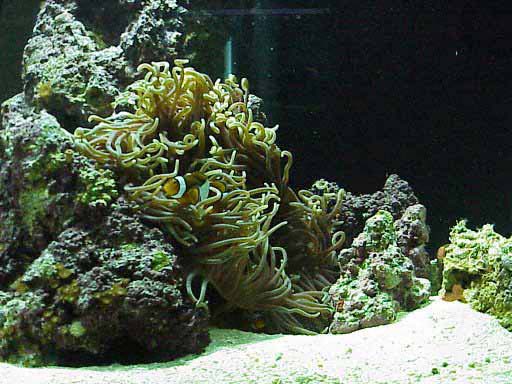
Macrodactyla doreensis
Picture taken April 1999, Sony Mavica FD91 digital camera, no flash Purchased: April 27, 1997 This was my first anemone. A beginners mistake. The image of clown fish swimming in an anemone was what originally lured me into the saltwater hobby. Beginners should stay away from such delicate creatures until they have experience under their reef keeping belt. This picture shows it during its first week after being moved to my 180g tank. |
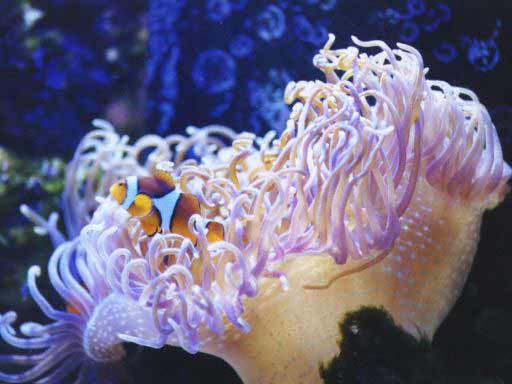
Macrodactyla doreensis. Picture taken October 1999.
Minolta 7000 SLR ASA200 35mm, no flash, (scanned) This anemone was the size of a golf ball when I first got it in April 1997. It has since grown to a full size near 17 inches tall and 15 inches wide in my 55g tank. Now under metal halide lighting it does not need to stretch out so much. This anemone has been through a lot with me including a full live rock tank cure and two tank moves. Moving this critter is no easy task and not something I want to do again. This anemone is a host to a mated pair of Percula Clownfish that spawn twice a month. Care for this anemone is difficult and easy at the same time. Setting up a location it likes and preventing it from wandering around the tank is not easy. But once it has settled in, I just need to feed it thawed frozen shrimp soaked on Selcon vitamin supplements once a week. To the left you can see the anemone after being in the 180g tank for 7 months. This picture also shows the anemone with 250w Iwasaki 6500K and actinic lights on. |
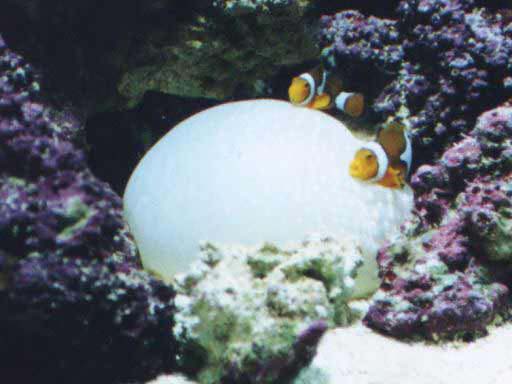
Macrodactyla doreensis. Picture taken October 1999.
Minolta 7000 SLR ASA200 35mm, no flash, (scanned) When the anemone gets spooked it will expel water and fold its tentacles inward to protect itself. Sometimes it will go completely under the sand and nothing will be visible. In any event the clownfish don't like it as they loose their protection. |
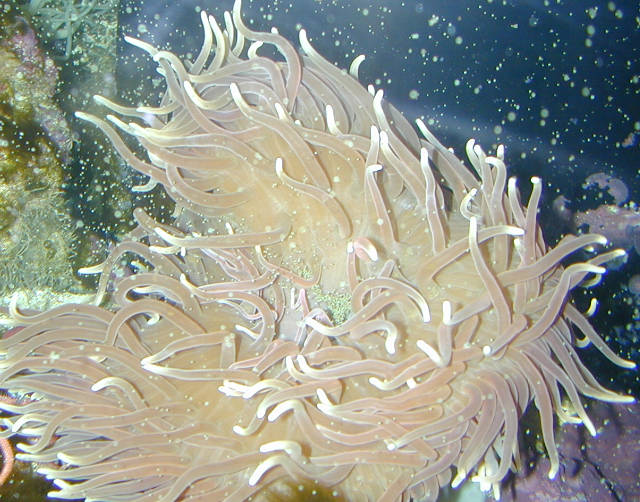
Macrodactyla doreensis
Picture taken June 2000, Nikon Coolpix 950 Digital Camera at night, full flash On the night of June 6th, 2000 while getting ready to give the anemone its weekly feeding the anemone started to release thousands of eggs. In this picture you can see them streaming from the mouth of the anemone and you can see them floating in the water column all over the picture. The anemone was standing very tall, with a large bulge in the body column just before it started to release its eggs. |
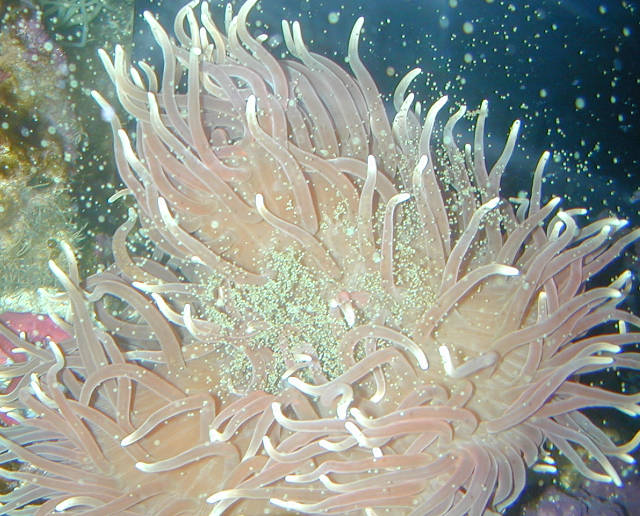
Macrodactyla doreensis
Picture taken June 2000, Nikon Coolpix 950 Digital Camera at night, full flash In this picture you can see another surge of eggs being released. In my rush to get pictures I never counted how many surges of these eggs happened, nor did I time how long the egg release event lasted. I had bigger fears of thousands of eggs dying in the tank and fouling the water. Within 5 minutes of the pictures the tank water was completely white and nothing at all could be seen inside the tank even with a flash light. I feared I would loose all my fish from oxygen depravation from the bacteria bloom that would be trigged by the eggs decomposing. I quickly put a sponge filter on to remove the eggs and increased surface agitation. The skimmer went flat and stayed that way for about 3 days. I was lucky in that I had no losses and I was able to watch a very rare event happen before my eyes. If I had not been home to deal with the crises it could have been a very different outcome. |
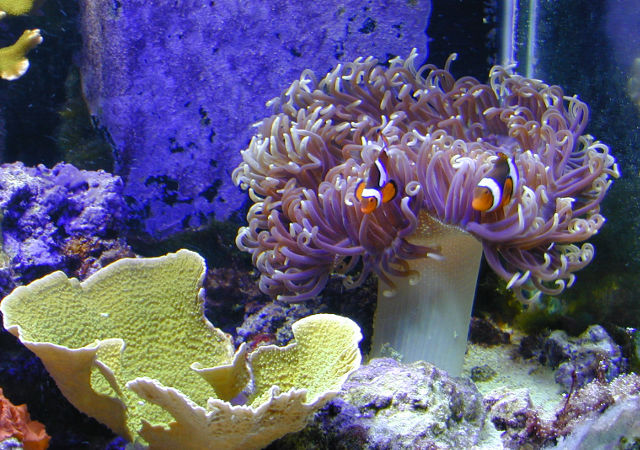
Macrodactyla doreensis (getting ready to spawn)
Picture taken December 2001, Nikon Coolpix 950 Digital Camera, no flash On the night of December 17th, 2001 the anemone spawned again. This time I had a feeling it was going to happen based on how the anemone was standing upright away from the rocks (as pictured to the left). I missed the start of the spawn, but I was able to watch about 10 minutes of it. The clownfish ate as many eggs as they could catch while they were being released. The other fish had a feast as well and all corals were fully extended trying to catch their share. I was unable to get any decent pictures of the spawn this time. All of them were out of focus. Didn't look much different then the pictures of the previous spawn. |
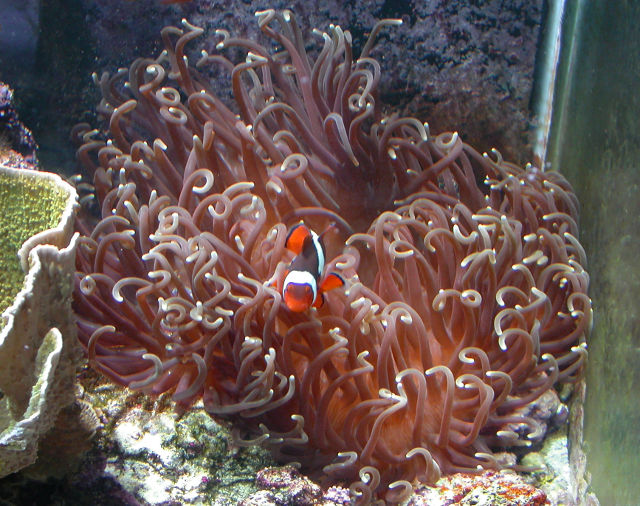
Macrodactyla doreensis
Picture taken August 2002, Nikon Coolpix 950 Digital Camera, Titanium Lens, no flash The anemone moved its foot over a few inches to get a little more room between it and the montipora it is next to. In the picture you can see the female clown keeping an eye on me. The male clown is under the anemone in the back corner tending to newly laid eggs. |
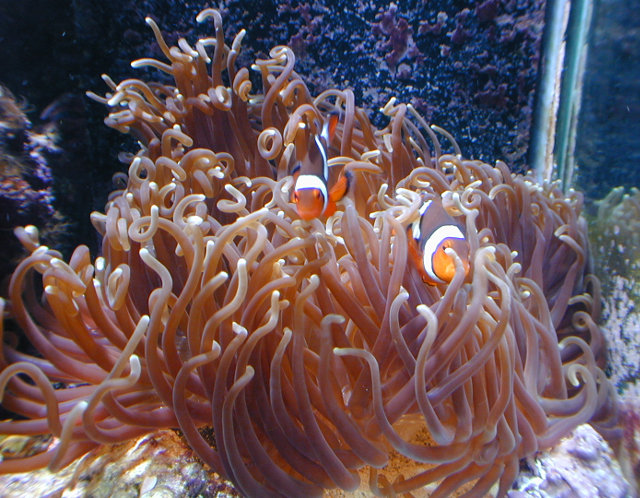
Macrodactyla doreensis
Picture taken September 2002, Nikon Coolpix 950 Digital Camera, Titanium Lens, no flash You just can not help smiling watching clownfish bob up and down while swimming amoung the tentacles of an anemone. |
